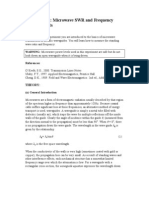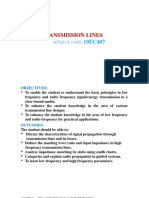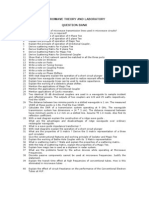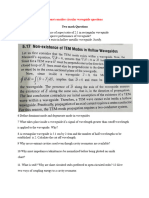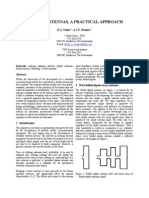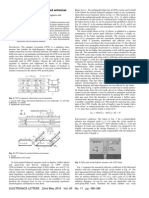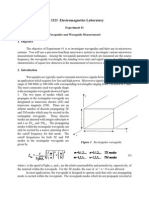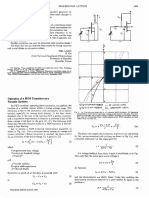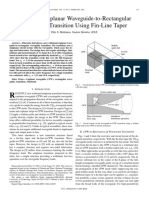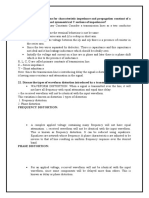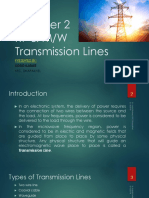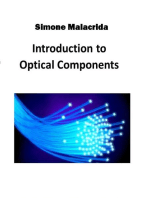W - C L T: Aveguide Oaxial INE Ransitions
W - C L T: Aveguide Oaxial INE Ransitions
Uploaded by
sandhraCopyright:
Available Formats
W - C L T: Aveguide Oaxial INE Ransitions
W - C L T: Aveguide Oaxial INE Ransitions
Uploaded by
sandhraOriginal Description:
Original Title
Copyright
Available Formats
Share this document
Did you find this document useful?
Is this content inappropriate?
Copyright:
Available Formats
W - C L T: Aveguide Oaxial INE Ransitions
W - C L T: Aveguide Oaxial INE Ransitions
Uploaded by
sandhraCopyright:
Available Formats
Waveguide-Coaxial Line Transitions
Peter Delmotte, ON4CDQ
WAVEGUIDE-COAXIAL LINE TRANSITIONS
Peter Delmotte, ON4CDQ
1. Overview
Equipment at microwave frequencies is usually based on a combination of PCB and
waveguide components. Filters and antennas often use waveguide techniques,
whereas the active circuitry is most easily built on a PCB in a microstrip or coplanar
form interfaced with coaxial interconnects. Some other components, like relays, are
only available with coaxial connections. To interconnect coax, microstrip and
waveguide devices it is necessary to use suitable transducers.
There are basically four families of transducers1:
a) Reactively Tuned Transitions
b) Resistively Matched Transitions
c) Mode Matched Transitions
d) Miscellaneous, empirically designed, Transitions
a) Reactively Tuned Transitions
In this type of transition, coaxial line and waveguide differ widely in impedance. A
match is obtained by incorporating suitable shunt (parallel) and series reactances.
These transitions typically consist of a right-angled junction of waveguide and coaxial
line, where the centre conductor of the coaxial line protrudes through the broad wall
into the waveguide to form an "aerial" inside. Tuning is achieved by the use of a
shorted waveguide stub and by adjusting or modifying the centre conductor (Figure 1).
Figure 1 : Reactively tuned transition
The Simple Transition
In this arrangement, shown in Figure 2, the length of the centre conductor is adjusted
to obtain a match. This device is rather narrow banded, but a lot of applications dont
require a perfect match over the whole waveguide bandwidth. The simple transition is
discussed in greater detail in the next chapter.
Belgian Microwave Roundtable, 2001
Waveguide-Coaxial Line Transitions
Peter Delmotte, ON4CDQ
Figure 2 : The Simple Transition
The Coaxial Stub-Tuned Transition
In this arrangement, shown in Figure 3, the centre conductor traverses the
waveguide and is terminated in a coaxial stub. This type of transition forms the basis
of crystal, thermistor and bolometer mounts. It permits the connection of lower
frequency circuits to the centre conductor through the use of simple low- pass filters
mounted at the end of the stub.
A typical application is a waveguide mixer, in which a cylindrical mixer diode takes
the place of the centre conductor and the IF signal is applied at the end of the stub.
Figure 3 : The Coaxial Stub Tuned Transition
b) Resistively Matched Transitions
In resistively matched transitions the size or shape of the waveguide at the point of
connection to the coaxial line is such that the impedances of the waveguide and
coaxial line are equal.
This type of transition is basically a stub-tuned device in which the stub has a zero
length. The waveguide and coaxial line impedances are made equal whilst the post
diameter is adjusted to tune out the reactances. By terminating the waveguide in a
quarterwave choke, the shunt susceptance is made zero.
The Simple Resistively Matched Transition
The conditions for a match are: Zo=Zc and xa=xb (
Figure 4). This means that the coaxial and waveguide line impedances have to be
equal. As a consequence, standard waveguides cannot be matched to standard
coax. Transition from normal waveguide to low impedance guide is by one of the
usual techniques: transformer(s) or taper.
Belgian Microwave Roundtable, 2001
Waveguide-Coaxial Line Transitions
Peter Delmotte, ON4CDQ
Figure 4 : Simple Resistively Matched Transition
Zc is the impedance of the coaxial line; the inductance and capacitances in the
equivalent network are related to the length and radius of the probe.
c) Mode Matched Transitions
In mode matched transitions the transition from waveguide to coaxial line is made
smoothly, allowing the modes to blend gently from one to another.
Figure 5 : Mode Matched Transition Sections
A mode-matched transition described by Miles2 consists of a length of transmission
line of varying section. The waveguide section is at one end, the coaxial line at the
other. The change of section is shown diagrammatically in Figure 5.
In the original design, the impedance is maintained throughout the transmission line
but clearly this may be changed during all or part of the tapering process to allow
transformation between waveguides and coaxial lines of conventional dimensions
and different impedances. Modelling of this type of transitions is most easily done
with numerical techniques.
The following rules increase the success rate:
1. The field must be essentially transversal. Avoid bends and corners.
2. Changes in impedance must be made slowly, say 2 or 3:1 per wavelength.
Belgian Microwave Roundtable, 2001
Waveguide-Coaxial Line Transitions
Peter Delmotte, ON4CDQ
d) Miscellaneous, Empirically Designed, Transitions
Many designs are based on experimental data. Their performance is being optimised
with the aid of a simplified theory. They dont respond very well to theoretical
analysis, but have proven their use in practice. Nowadays, even these types of
transitions can be modelled very accurately using 3-D numerical field solvers, so we
might as well call them numerically optimised transitions. An example is shown in
3
Figure 6. This transition, designed by Wheeler , is basically a resistively matched
transition to a multi-ridged waveguide. This transition is followed by a multi-ridged to
normal waveguide transformer. Since this type of transition has over ten critical
degrees of freedom, it is virtually impossible to describe it analytically. On the positive
side, the achievable bandwidth with this design is far greater than that of the
reactively tuned simple transition.
Figure 6 : Wheeler'
s Normal Transition
2. Analysis of a Simple Transition
We will now go into detail on how to design a simple transition, the easiest and most
versatile type of coax-waveguide adapter.
Figure 7 : The Simple Transition
The reference plane T for our calculations is the plane that separates the waveguide
from the coaxial line. The right side of the waveguide is represented by a resistor
equal to the waveguide impedance. The transition is represented by a capacitive
reactance, (equivalent to a post) in series with the coaxial line. The waveguide is
shunted with the equivalent susceptance of the waveguide stub, the left part of the
waveguide (Figure 7).
A capacitive post (a metal rod or screw protruding the broad wall of a waveguide) is
often represented electrically by a tee network, in which the shunt susceptance 1/x1
is usually much greater than the series reactances x2 (Figure 8).
Belgian Microwave Roundtable, 2001
Waveguide-Coaxial Line Transitions
Peter Delmotte, ON4CDQ
Figure 8 : The Capacitive Post and Equivalent Circuit
The small series reactance of the post in the coax-waveguide transition is neglected.
As seen in Figure 7, this simplification reduces the simple transition to nothing more
than a L-C impedance matching network. The coaxial line impedance has to be
matched to the (frequency dependent) waveguide impedance. ( Z WG = 120 g )
Unfortunately, no simple expressions for L and C exist.
It can be shown that when looking from the coaxial line at the plane of the waveguide
wall the input impedance Zi is given by:
Z i = R + jX
where
(1)
R=
Z 0 g
sin 2 (2 l g ) tan 2 ( d )
2 2 ab
X =
Z 0 g
d
tan 2
2 X P + sin (4 l g )
2
4 ab
(2)
(3)
with
Z 0 = 0 0 = 120
XP = reactance of the post normalised with respect to the waveguide
impedance
Since XP is a function of d, it is apparent that, by a suitable adjustment of d and l, the
input impedance may be equated to the impedance of the coaxial line.
For an input match we should have X=0:
2 X P = sin (4l g )
XP 1 2
The post is thus very close to resonance (XP = 0).
Various equations to XP are available. However, they must be used with caution in
this near resonance condition. Normally the post height d is approximately one
Belgian Microwave Roundtable, 2001
Waveguide-Coaxial Line Transitions
Peter Delmotte, ON4CDQ
quarter wavelength at resonance. If this is significantly less than b the equations are
applicable. On the other hand, if b < /4, the resonance condition is obtained through
the action of the capacity between the end of the post and the waveguide wall. In this
circumstance the tuning is critically dependent on (b d) and the exact profile of the
post tip. Designs using this mode of tuning are basically unsound and discouraged.
Using Collin'
s4 expression for x, given by equation (4), in equations (1), (2) and (3):
XP =
a
2 g
sin 2 (m d 2b )
2a 0.0518k 02 a 2
2r
2
ln
2
1
2
k
1
+
0
r
a
2
sin 2 (k 0 d 2 )
m =1
K 0 (k m r )
k m2
(4)
k m2 = (m b ) k 02
2
Other useful data/formulas:
0.25 for TE10 rectangular waveguide modes.
Centre diameter of a SMA chassis jack : 1.3mm
Graphs for R and X as functions of d and l can be plotted for different waveguide
dimensions, probe radiuses and frequencies.
WR90 @ 10.368GHz
a = 0.90 = 22.86
b = 0.40 = 10.16
= 28.9 mm
g = 37.4 mm
r = 0.65 mm
WR42 @ 24.192GHz
a = 0.42 = 10.67 mm
b = 0.17 = 4.32 mm
= 1.24 mm
g = 1.52 mm
r = 0.65 mm
Belgian Microwave Roundtable, 2001
Waveguide-Coaxial Line Transitions
Peter Delmotte, ON4CDQ
WR34 @ 24.192GHz
a = 0.34 = 8.64 mm
b = 0.17 = 4.32 mm
= 1.24 mm
g = 1.78 mm
r = 0.65 mm
WR187 @ 5.76GHz
a = 1.8725 = 47.6 mm
b = 0.8725 = 22.2 mm
= 52.1 mm
g = 62.2 mm
r = 0.65 mm
Belgian Microwave Roundtable, 2001
Waveguide-Coaxial Line Transitions
Peter Delmotte, ON4CDQ
3. Design Results
Using the previous theoretical derivations, a few coax-waveguide transitions are
designed. The numbers obtained from the graphs served as the starting point for a
numerical optimization using a 3D field solver (HP HFSS, a numerical
electromagnetic modeller/solver based on finite elements).
The coaxial line is a standard SMA flange mount jack receptacle with extended
dielectric. The radius of the centre conductor, which is used as the coupling probe, is
0.65mm. (d and l as shown in Figure 7)
a) WR42 SMA Transition
shows a wireframe model and the return loss of the transition before
optimisation.
Figure 9
d = 2.7 mm, l = 3.2 mm
Figure 9 : Wireframe model and S11 of original design
Some tuning yields a better than -20dB match (Figure 10):
d = 2.2 mm, l = 3.0 mm
Figure 10 : Return loss of optimised design
To facilitate manufacturing, the rear corners of the waveguide are rounded with a
1.5mm radius. The effect on the return loss is hardly noticeable. (Figure 11)
Belgian Microwave Roundtable, 2001
Waveguide-Coaxial Line Transitions
Peter Delmotte, ON4CDQ
Figure 11 : Wireframe model and S11 of rounded design
Figure 12 : Aluminium WR42 - coax adapter
b) WR34 SMA Transition
This type of waveguide is less common than the WR42 version. Recently however,
we could obtain a used MilliWave medium power amplifier. This amplifier is equipped
with WR34 in- and output ports.
Figure 13 shows a matching adapter for these amplifier modules. (d = 2.0 mm; l = 2.8
mm) The aluminium body of the adapter does double duty as a heatsink.
Figure 13 : MilliWave Amplifier and matching coaxial adapter
Belgian Microwave Roundtable, 2001
Waveguide-Coaxial Line Transitions
Peter Delmotte, ON4CDQ
c) WR187 SMA Transition
We (ON4CP) recently added 6 cm to our contest station. Our antenna is a cheap 80
cm DSB offset dish with a homebrew (and home-designed) WR187 feedhorn (
Figure 14). Our feedhorn consists of a length of rectangular waveguide with WR187
inner dimensions (approximately 22 mm x 48 mm) followed by a 10.5 dBi horn. The
gain needed to illuminate a typical DSB offset dish is discussed by W1GHZ5. The
height/width ratio of the horn is 2/, the ratio needed to create equal beamwidths in
both E and H plane (the symmetry planes of the horn)
After optimisation, the critical parameters of the transition are: d= 13mm, l = 11mm.
The waveguide section and matching horn were folded out of a 0.5 mm copper
sheet.
Figure 15 shows the layout of the horn in true size.
Figure 14 : C Band Offset Feed
Belgian Microwave Roundtable, 2001
10
Waveguide-Coaxial Line Transitions
Peter Delmotte, ON4CDQ
Figure 15 : Layout of a C Band offset feed
Belgian Microwave Roundtable, 2001
11
Waveguide-Coaxial Line Transitions
Peter Delmotte, ON4CDQ
4. Some Remarks Regarding the Agreement Between the Analytical and
the Numerical Results
Our analytical approach in the first chapter, although it is quite useful, is not accurate
enough to allow a one-shot design. During the derivation of the formulas some
approximations were made. The coaxial aperture in the waveguide is not modelled,
and the thickness of the probe is considered small with respect to the length. As a
result of these approximations, both the resistive (R) and reactive (X) part of the
transition impedance are underestimated. This results in its turn in an overestimation
for d and l of typically 15%.
W.B.W. ALISON, A Handbook for the Mechanical Tolerancing of Waveguide Components,
pp. 384-468, 1972.
2
G.R. MILES, A Waveguide to Coaxial Line Transformer, Electronic Components pp. 821824, Aug. 1963.
3
G. J. WHEELER, Introduction to Microwaves, 1963.
4
R.E. COLLIN, Field Theory of Guided Waves, pp. 258-271, 1960.
5
W1GHZ, W1GHZ Microwave Antenna Book Online, http://www.qsl.net/n1bwt/.
Belgian Microwave Roundtable, 2001
12
You might also like
- XII Physics Practical Question Slips NotesDocument7 pagesXII Physics Practical Question Slips NotesRavindra Waykole33% (3)
- 19 - 231 - HVDC - 01 - Annex 5 - ETF HVDC (English) Rev.1Document116 pages19 - 231 - HVDC - 01 - Annex 5 - ETF HVDC (English) Rev.1Enver Rojas DiazNo ratings yet
- List of Contents: S/No. Subject Page NumberDocument24 pagesList of Contents: S/No. Subject Page NumberAbdelrahman DaakirNo ratings yet
- Experiment5 SimulationStudyDocument12 pagesExperiment5 SimulationStudyRishikant KashyapNo ratings yet
- Pulses in Cables: ReferencesDocument5 pagesPulses in Cables: ReferencesPaul DumitruNo ratings yet
- 1 Theory: 1.1 Coplanar 2d-Waveguide StructuresDocument9 pages1 Theory: 1.1 Coplanar 2d-Waveguide StructuresSebastianMeierNo ratings yet
- Band Stop Filter TodayDocument4 pagesBand Stop Filter TodayrehanNo ratings yet
- Translines ProjectDocument8 pagesTranslines ProjectOdellien SajaNo ratings yet
- Circuit Simulation of Varactor Loaded Line Phase Shifter: V C V CDocument4 pagesCircuit Simulation of Varactor Loaded Line Phase Shifter: V C V CdhvbkhnNo ratings yet
- High Performance Rogowski Current Transducers: W. F. Ray and C. R. HewsonDocument8 pagesHigh Performance Rogowski Current Transducers: W. F. Ray and C. R. HewsongovindarulNo ratings yet
- Experiment 2: Microwave SWR and Frequency Measurements: AimsDocument5 pagesExperiment 2: Microwave SWR and Frequency Measurements: Aimsspyr0% (1)
- EES4400 L1 TL Smith Chart Network Parameters 2023 4Document66 pagesEES4400 L1 TL Smith Chart Network Parameters 2023 4qianzanwumuNo ratings yet
- Jurnal IpaDocument19 pagesJurnal IpaOchikaAyChieNo ratings yet
- Lecture 7-1Document29 pagesLecture 7-1ktekk5105No ratings yet
- 2019 Problems in Electromagnetics Vol 1Document35 pages2019 Problems in Electromagnetics Vol 1soumengoswami10No ratings yet
- Chapter Two: Review of Network Parameters & Transmission Line TheoryDocument43 pagesChapter Two: Review of Network Parameters & Transmission Line Theorygetahun fentawNo ratings yet
- Mstrip-Slot Transtion MOTL98Document4 pagesMstrip-Slot Transtion MOTL98Sreedhar GundlapalliNo ratings yet
- AE72 - Microwave Theory & TechniquesDocument16 pagesAE72 - Microwave Theory & TechniquesKamal Singh Rathore100% (1)
- Communications 2 EE555Document159 pagesCommunications 2 EE555ganadim9795No ratings yet
- Design of Robust RF-MEMS Phase Shifters in Ka-BandDocument13 pagesDesign of Robust RF-MEMS Phase Shifters in Ka-Bandloga rajesh waranNo ratings yet
- Wideband Dual Posts Waveguide Band Pass FilterDocument7 pagesWideband Dual Posts Waveguide Band Pass FilterAmador Garcia IIINo ratings yet
- TLWDocument15 pagesTLWanon_846897733No ratings yet
- Microwave Filter DesignDocument50 pagesMicrowave Filter Designsimsook91100% (1)
- Very Narrow Base DiodeDocument10 pagesVery Narrow Base DiodeFer Fer NandoNo ratings yet
- Presentation - UNIT-1Document68 pagesPresentation - UNIT-1Dr.A.K. ShrivastavNo ratings yet
- Research Article: Compact Triple-Band Antenna Employing Simplified Mtls For Wireless ApplicationsDocument7 pagesResearch Article: Compact Triple-Band Antenna Employing Simplified Mtls For Wireless Applicationsabbasamiri135103No ratings yet
- Transmission LinesDocument80 pagesTransmission Linesadithya_kashyap_1No ratings yet
- Mwttextbook 1Document106 pagesMwttextbook 1chanuNo ratings yet
- Microwave CommunicationsDocument6 pagesMicrowave CommunicationsAkhil AhmedNo ratings yet
- Microwave Engineering-Chapter 11-SampleDocument60 pagesMicrowave Engineering-Chapter 11-SampleVamshi KrishnaNo ratings yet
- Question Bank For MWEDocument10 pagesQuestion Bank For MWEShravani SurveNo ratings yet
- Module3 PDFDocument37 pagesModule3 PDFSadananda KrrishNo ratings yet
- Mini Circuits Vco DesignDocument7 pagesMini Circuits Vco Designtqminh1990No ratings yet
- 05 AtuDocument6 pages05 Atukartheek32777No ratings yet
- Viva QuestionsDocument8 pagesViva QuestionsPrabinjose100% (1)
- WWW - Stanford.edu Jbarral Downloads JoelleBarral CoilDesignDocument9 pagesWWW - Stanford.edu Jbarral Downloads JoelleBarral CoilDesignSachin_AnchanNo ratings yet
- Surge Propagation in Electrical SystemsDocument5 pagesSurge Propagation in Electrical SystemssamiNo ratings yet
- Near-Field Loop Antenna For The UHF RFID Reader: Peng Yang, Yan Li, Li-Jun Jiang, and Feng YangDocument5 pagesNear-Field Loop Antenna For The UHF RFID Reader: Peng Yang, Yan Li, Li-Jun Jiang, and Feng YangDuc DucNo ratings yet
- Circular WaveguideDocument19 pagesCircular WaveguideLam DinhNo ratings yet
- Textile Antennas, A Practical Approach: H.J. Visser, A.C.F. ReniersDocument8 pagesTextile Antennas, A Practical Approach: H.J. Visser, A.C.F. ReniersOsman Demir100% (1)
- Balun DesignDocument2 pagesBalun DesignUtah UtahNo ratings yet
- Question Bank With Sol (BEFORE MID-SEM)Document81 pagesQuestion Bank With Sol (BEFORE MID-SEM)Atul SahNo ratings yet
- Forced Vibration Sinusoidal ManualDocument6 pagesForced Vibration Sinusoidal ManualB01Aadarsh SharmaNo ratings yet
- Microwave Viva QuestionsDocument28 pagesMicrowave Viva Questionsqwerty100% (2)
- Ece 3323 Experiment 1Document11 pagesEce 3323 Experiment 1TANQUERO_WW20% (2)
- Bilotti 1966Document3 pagesBilotti 1966dycsteiznNo ratings yet
- Wideband Coplanar Waveguide-To-rectangular Waveguide Transition Using Fin-Line TaperDocument3 pagesWideband Coplanar Waveguide-To-rectangular Waveguide Transition Using Fin-Line TapernshNo ratings yet
- Part BDocument9 pagesPart Bsramalingam288953No ratings yet
- Some Aspects of The Design of Balanced Rectifier Modulators For Precision ApplicationsDocument12 pagesSome Aspects of The Design of Balanced Rectifier Modulators For Precision ApplicationsshirtquittersNo ratings yet
- TLRF 2m PDFDocument25 pagesTLRF 2m PDFDeepthi SL CreationsNo ratings yet
- Mode MatchingDocument6 pagesMode MatchingaxNo ratings yet
- Microwave Circuits: Stripline & MicrostripDocument29 pagesMicrowave Circuits: Stripline & MicrostripRocky BobNo ratings yet
- Microwave Engineering-Transmission LinesDocument29 pagesMicrowave Engineering-Transmission LinesKobid KarkeeNo ratings yet
- High Power VHF Frequency-Hopping FiltersDocument10 pagesHigh Power VHF Frequency-Hopping FiltersA. VillaNo ratings yet
- High-Pass and Low-Pass FiltersDocument5 pagesHigh-Pass and Low-Pass FiltersnayrochfrNo ratings yet
- Design of Rectangular Microstrip Patch Antennas For The 2.4 GHZ BandDocument7 pagesDesign of Rectangular Microstrip Patch Antennas For The 2.4 GHZ BandkarimbebNo ratings yet
- Feynman Lectures Simplified 2C: Electromagnetism: in Relativity & in Dense MatterFrom EverandFeynman Lectures Simplified 2C: Electromagnetism: in Relativity & in Dense MatterNo ratings yet
- Analysis and Design of Multicell DC/DC Converters Using Vectorized ModelsFrom EverandAnalysis and Design of Multicell DC/DC Converters Using Vectorized ModelsNo ratings yet
- Questions, Numerical Problems, Examples (Part-1)Document32 pagesQuestions, Numerical Problems, Examples (Part-1)mushtaq ahmadNo ratings yet
- Al Nahda National Schools (Boys) Physics Grade: 12G, H & I Worksheet: Capacitors Teacher: Nidal Al HalabiDocument10 pagesAl Nahda National Schools (Boys) Physics Grade: 12G, H & I Worksheet: Capacitors Teacher: Nidal Al HalabiSean Captain HonestlagoNo ratings yet
- Aurora C# Unofficial Manual v0.1.4Document63 pagesAurora C# Unofficial Manual v0.1.4twehtesdfazdhadhNo ratings yet
- 4.1 SolutionsDocument5 pages4.1 SolutionsNamdeo JadhavNo ratings yet
- SMPSDocument19 pagesSMPSPrathibha SundaramurthyNo ratings yet
- 4 Coupling Mechanisms and Counter-Measures: 4.1 GeneralDocument6 pages4 Coupling Mechanisms and Counter-Measures: 4.1 GeneralMidhun VargheseNo ratings yet
- Grav Fields A2 M4Document55 pagesGrav Fields A2 M4aby251188No ratings yet
- Mechanical Engineering Interview Questions and AnswersDocument5 pagesMechanical Engineering Interview Questions and AnswersAlexandru NistorNo ratings yet
- Simulation Of Physical Problems With Matlab Gui Topic: Coriolis Force Student: Đinh Thúy Hiền Class: KK68 I. Physical ProblemDocument13 pagesSimulation Of Physical Problems With Matlab Gui Topic: Coriolis Force Student: Đinh Thúy Hiền Class: KK68 I. Physical ProblemHiền Đinh ThúyNo ratings yet
- LS2 LAS (Friction and Gravity)Document15 pagesLS2 LAS (Friction and Gravity)als midsayap1No ratings yet
- CBSE Class 10 Physics Sample Questions 2020Document2 pagesCBSE Class 10 Physics Sample Questions 2020misostudyNo ratings yet
- Arthur Bieser Solution Chap 2Document21 pagesArthur Bieser Solution Chap 2Sma Shamsi45% (20)
- Rigid Body Dynamics: OutlineDocument6 pagesRigid Body Dynamics: OutlinenhNo ratings yet
- 50kW TX Operation ManualDocument161 pages50kW TX Operation ManualtamiratNo ratings yet
- 2013 Physics 123 Friction LabDocument5 pages2013 Physics 123 Friction Labnesh07No ratings yet
- Design Steps of LV HV WindingDocument2 pagesDesign Steps of LV HV WindingJatin Yadav100% (4)
- 7.1 Application of Geophysics in EngineeringDocument19 pages7.1 Application of Geophysics in EngineeringDenver John TejadaNo ratings yet
- Carta de Smith PDFDocument1 pageCarta de Smith PDFLuis SanchezNo ratings yet
- 12 Class Physics 1-Chapter Sample Paper PDFDocument9 pages12 Class Physics 1-Chapter Sample Paper PDFharshNo ratings yet
- Design of Renewable Energy Systems-1Document118 pagesDesign of Renewable Energy Systems-1Sameh Haj AliNo ratings yet
- EE133 Final-Examination MauhayDocument8 pagesEE133 Final-Examination MauhayJohn Zyrus MauhayNo ratings yet
- Apbx g7 Tech. Sheet Tech SheetDocument1 pageApbx g7 Tech. Sheet Tech SheetElena CagniNo ratings yet
- I Pu Mid-Term Set-2 - Pcmbekh - QP 2024-25Document24 pagesI Pu Mid-Term Set-2 - Pcmbekh - QP 2024-25angadijyothi98No ratings yet
- Hkwol KKFN LVSFVD Iapj Ijh (K.K (Lh-Ch-Vkj-Ijh (K.K) : HKKJRH EkudDocument10 pagesHkwol KKFN LVSFVD Iapj Ijh (K.K (Lh-Ch-Vkj-Ijh (K.K) : HKKJRH EkudBinayak KumarNo ratings yet
- Fault Scenario Simulation in A Feeder: Transmission and Distribution of Electrical PowerDocument32 pagesFault Scenario Simulation in A Feeder: Transmission and Distribution of Electrical PowerriteshtiroleNo ratings yet
- Permeability (Electromagnetism) : From Wikipedia, The Free EncyclopediaDocument6 pagesPermeability (Electromagnetism) : From Wikipedia, The Free Encyclopediaparallax1957No ratings yet
- MOSFET Selector Guide Definitions: Status DescriptionDocument84 pagesMOSFET Selector Guide Definitions: Status DescriptionBanyugeaNo ratings yet
- NEPLAN B02 ShortCircuit EnglDocument2 pagesNEPLAN B02 ShortCircuit EnglsdiamanNo ratings yet










